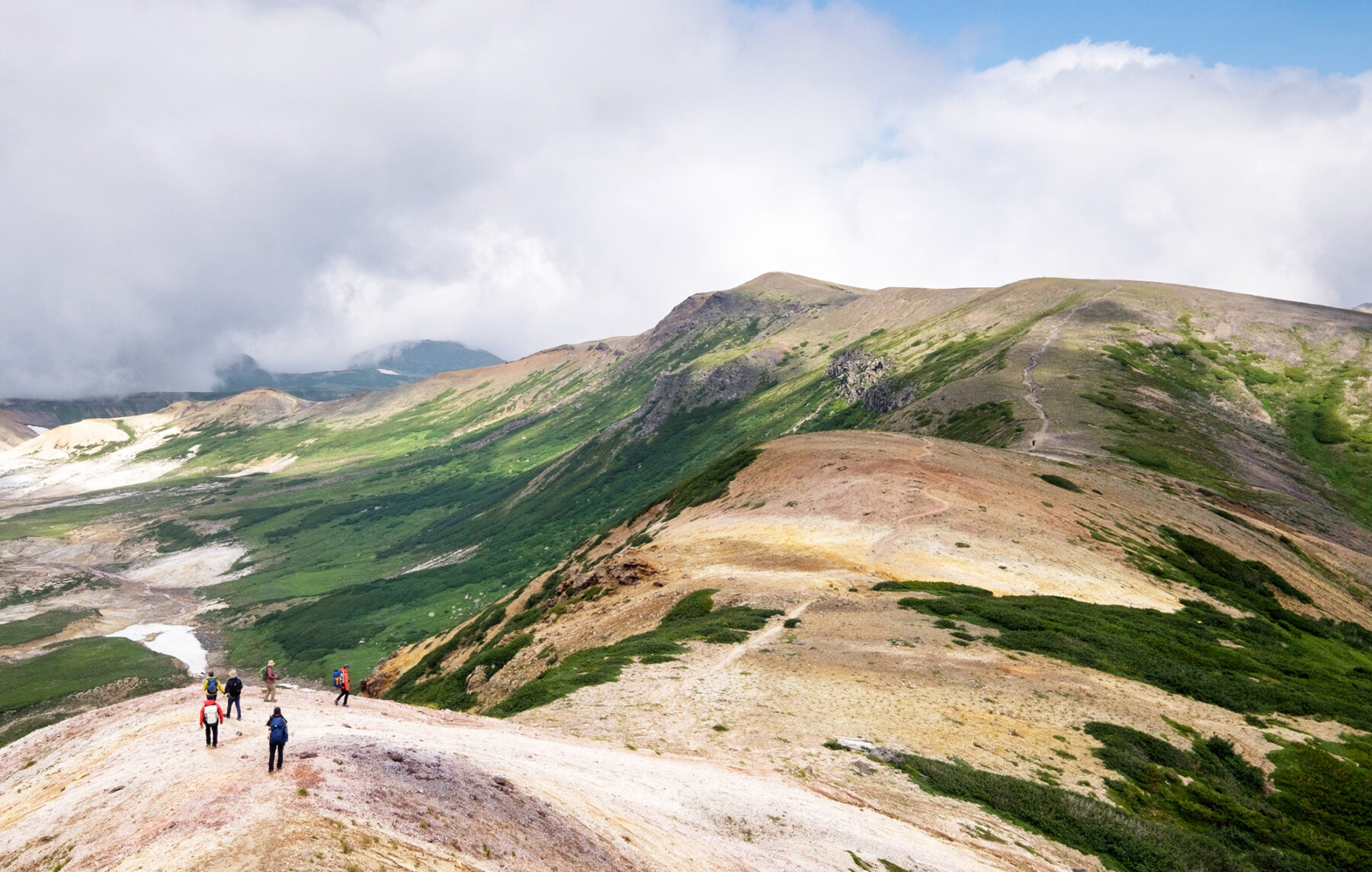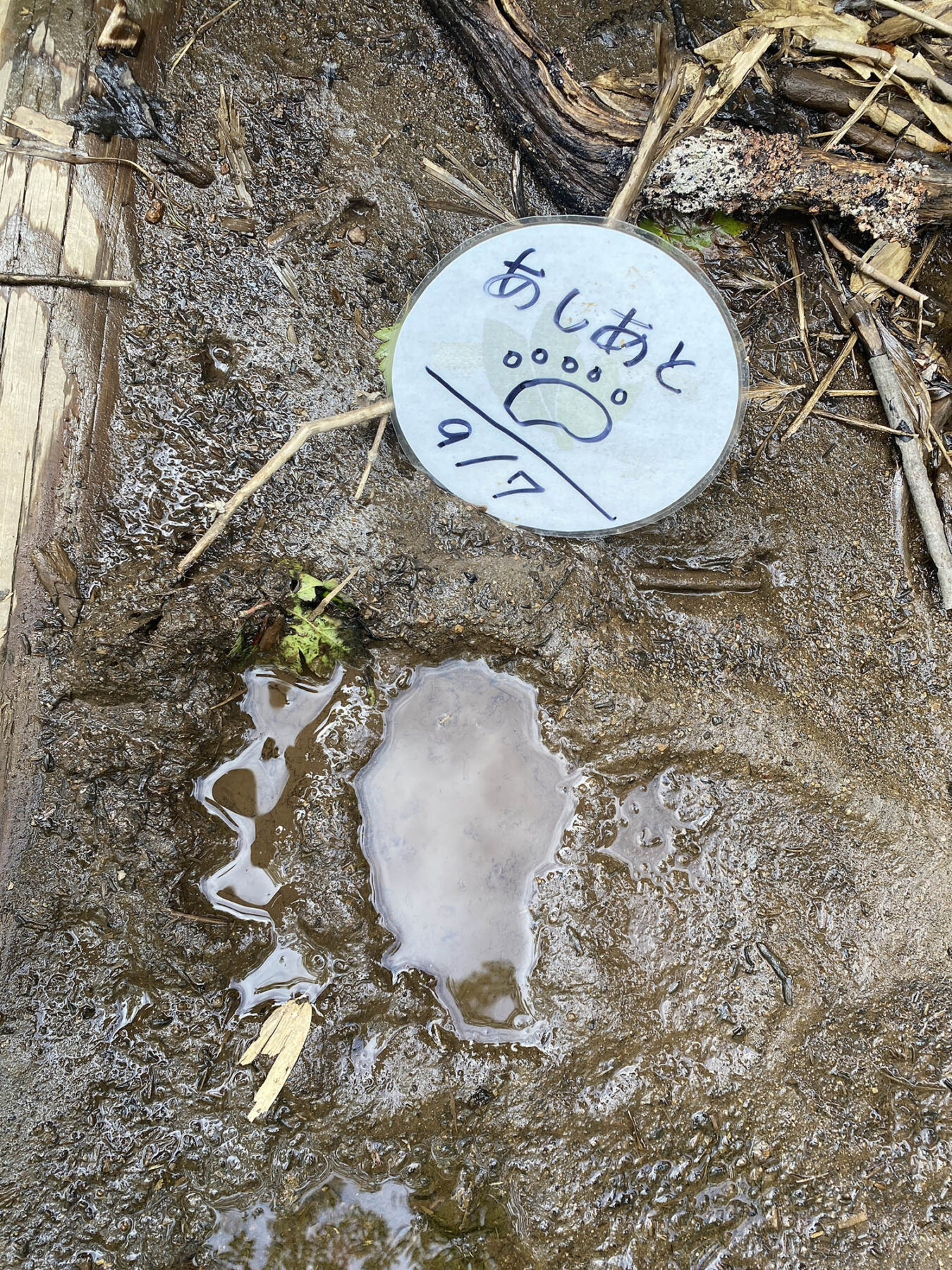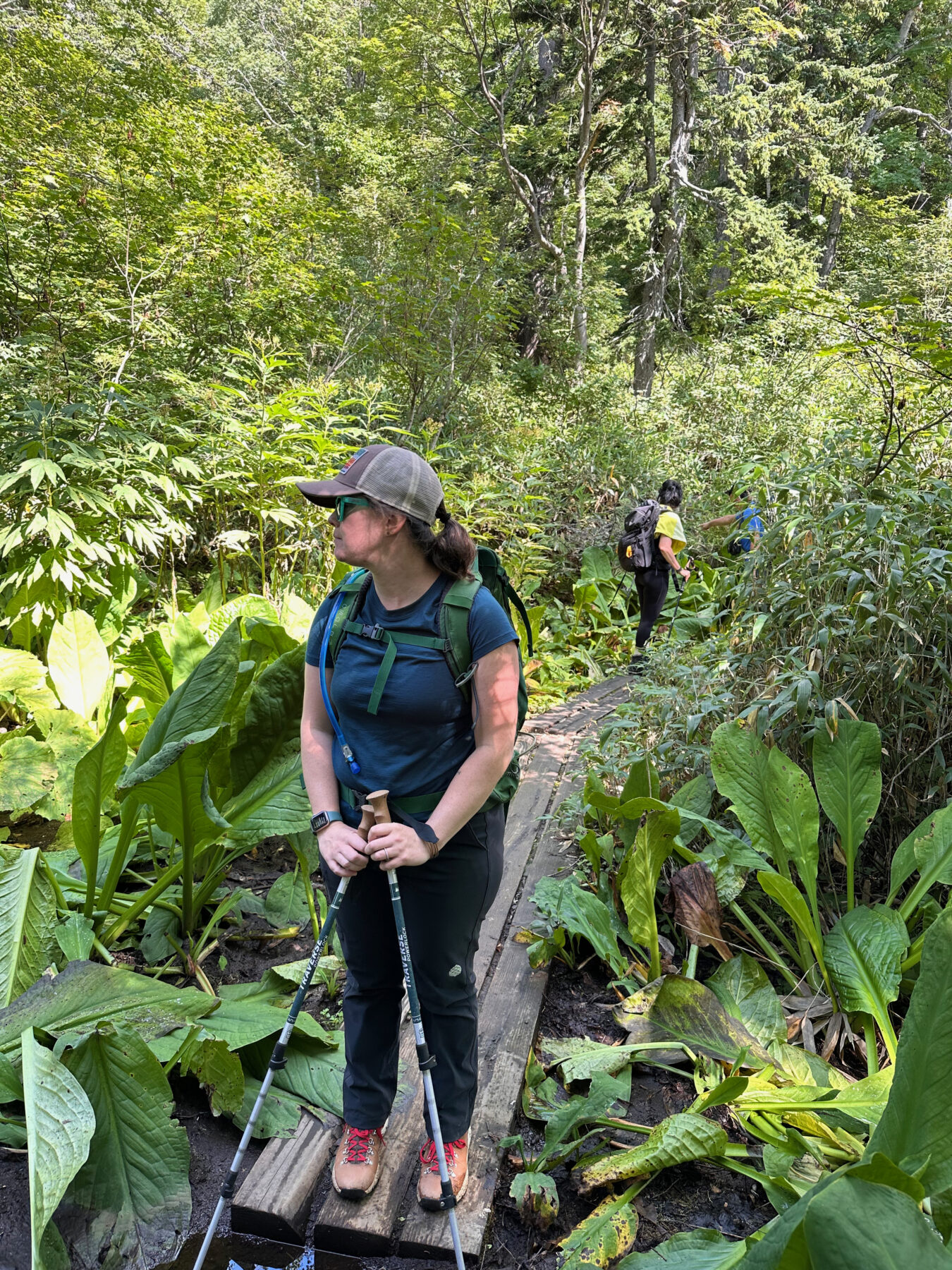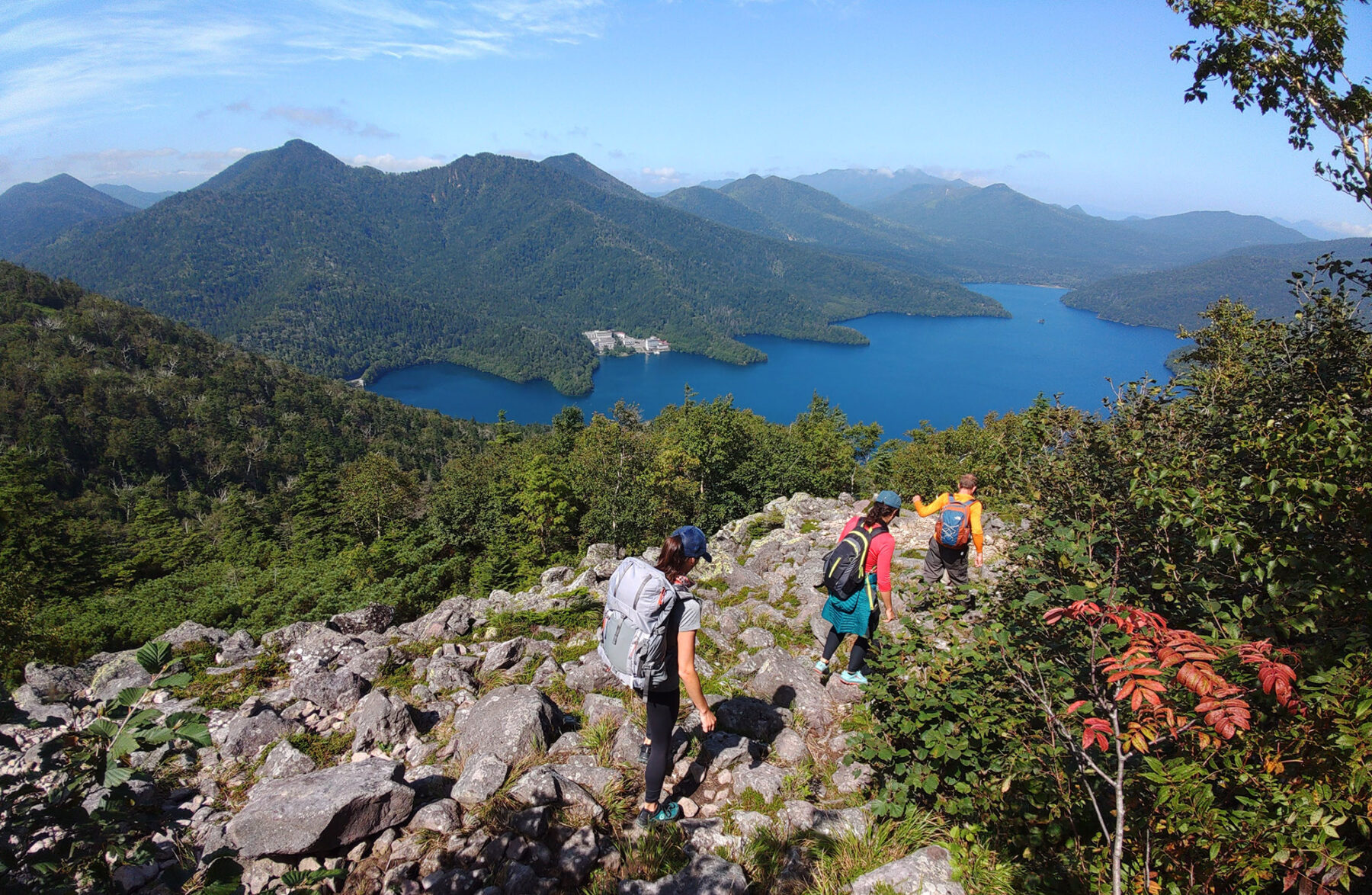Japanese writer and poet Keigetsu Omachi said in 1923: “If you wish to know the height of a mountain, climb Mt. Fuji. If you wish to know the scale of a mountain, climb the Daisetsuzan Mountain Range.” I’ve never climbed Fuji, but on my first day hiking in Daisetsuzan, I’m in no doubt as to its vastness.

Three active volcano groups rupture from the heart of Japan’s northernmost main island and I first fully appreciate their scale from an exposed ridgeline somewhere between Mt Asahidake and Mt Kurodake. I turn a slow 360, taking in an endless panorama of mist-covered rippling mountains and collapsed calderas – some scoured bare to reveal rainbow-coloured earth, others smeared in emerald green and sprouting tufts of hardy alpine plants or thick bushes of Japanese stone pine. Not a trace of civilisation exists other than the faint wearing of a route in the scree beneath my boots.
I’m on the longest day-hike of a six-day trip around Daisetsuzan National Park with Adventure Hokkaido, and it’s no walk in the park. Actually, none of the walks in our itinerary are, but more on that later. Today’s goal is a mere 12km that’ll take us eight and a half hours at a steady pace and with minimal breaks, thanks to rugged terrain and 1080 metres (m) of elevation to climb.


Fortunately, staggeringly beautiful landscapes are an effective painkiller and there is no shortage here. Asahidake is an active stratovolcano and after a leg-up via cable car to 1600m, the route climbs a steep spur of grey volcanic gravel towards the summit. To our left, a few dozen fumeroles puff out cones of sulphuric steam but it’s not until we sidle along the lip of a sheer gully, offering bird’s eye views over the vents, that we experience them in all their noxious, eye-smarting glory. The roar sounds like a pounding waterfall.
Hiking in the playground of the gods
Around 300km of hiking trails drizzle across Daisetsuzan. The indigenous Ainu people believe the mountains to be the closest point to the realm of the gods, referring to them as the ‘playground of the gods’, and our route takes us over Hokkaido’s highest peak at 2291m.

From Asahidake’s summit, the group’s energy levels are high but this is just the start of an epic alpine traverse that will take us around the exposed Ohachidaira caldera rim over five more peaks before descending at Mt Kurodake. Embarking on it is like entering the Great Beyond.
I’m travelling with ten others, plus two guides: Yasu, a Hokkaido local, and Richard, a Brit who’s been living in Japan for eight years and whose understated trail descriptions we’ll soon learn to interpret. “Okay, we’ve got a bit of a steep descent ahead but nothing too bad,” he says as we descend a flank clad in volcanic gravel that’s about as secure as ball bearings. It’s so steep that at times I’m forced into a low crouch-slash-bum slide with Yasu holding onto my backpack like a dad guiding a child on training wheels.
The saddle beyond is wide open – green over dark dirt – then the rollercoaster climbs again, the views coming and going with a mist that periodically engulfs us. It rains. It even hails a little. Then it clears, unveiling a massive collapsed caldera whose swirls of ash-white earth decorate a vast valley.
It should probably come as no surprise that Daisetsuzan is so wild and other-worldly. Japan’s largest national park sprawls across 2300 square kilometres, and though 16 of its peaks rise above 2000m, the high latitude here means a comparable height on the mainland would be 3000m. Challenging alpine conditions – the mountains are buried in snow October to May – are de rigueur.
Then there’s the wildlife. Sika deer, Japanese pika (a rabbit relative that lives amongst rocks), chipmunks and squirrels are all very cute but the animal at the forefront of every mind is one that migrated over when Hokkaido was joined with Russia during the last ice age – the Ussuri brown bear (aka Russian grizzly). They’re mainly into berries, nuts, fish and small mammals, but have been known to chow down on the odd human now and again.
In hot water
“Okay we’ve got a little river crossing ahead,” says Richard. “Hopefully, the water isn’t too high.” Nothing ups the stakes on a river crossing like knowing the water is poisonous. The Akaishi River drains from Ohachidaira Caldera which contains a sulphuric hot spring in which two students died after soaking in it in the 1950s.
The river rushes like milky coffee, flowing fast over the rocks we need to step across and swamping around my boots. I don’t recall touching any of it as I cross, but the next handful of nuts I munch on definitely has the acrid tang of something that shouldn’t be going in my mouth.

Fortunately, other hot springs around here are far more therapeutic. Onsens are an integral part of Japanese life. “Some people have three soaks a day,” says Richard. They’re a place to zen out and reap the physical benefits of immersing in hot mineral water pumped from deep underground, and every night there’s one waiting for us at a ryokan or hotel.
If you’re not familiar with onsen bathing, there are a few things to note. Firstly, it’s a nude thang. Bathers strip down to birthday suits, have a thorough scrub down at little washing stations and then share the serenity (it’s silence or hushed voices only, here) soaking in steamy communal baths. Most are segregated by gender, though a few aren’t. The water’s mineral content varies (eg, magnesium, calcium, sodium chloride) but the general gist is that it improves circulation, skin moisture, joint pain and a host of other benefits. Basically, you couldn’t design a better way to finish a hard day of hiking.
There’s a bear in there
Day two is supposed to be a rest-day kind of day (there are no major climbs involved) but the five hours we spend ambling on the Daisetsu Kogen Alpine Ponds trail are still a reasonable workout.
It’s also bear central. About a dozen are resident in the immediate trail area, and a briefing at the visitor centre is mandatory before heading out. We’re told what to do if we encounter one (don’t run) and the position to adopt if we’re attacked (lie face down with hands behind heads and legs spread so they can’t roll you over).


Richard reassures us that the chance of an encounter is unlikely and a negative one, even more so. “They generally avoid humans if they can. They’re not interested in picking a fight unless you frighten them, get in the way of their cubs or they’re trying to fight you for food”.
Likelihoods aside, a bear rampaged through Hokkaido’s capital Sapporo (population two million) two years ago, maiming four people, and another was spotted in the countryside 100km north of Daisetsuzan six months ago with a pair of fishing waders in his mouth; the decapitated head of the human owner wasn’t far away. Carrying bear bells is a popular deterrent amongst hikers but none of the guides carry them. “There’s no evidence they work,” Richard says. “It’s better to make loud human-sounding noises.”
Conversation is boisterous when we launch on the trail through a grove of Asian skunk cabbage – a favourite food of the bears. It’s clearly been flattened in places by the passage of something heavy and a trailside tree is scarred with claw marks. Within a few hundred metres little flags start appearing indicating paw prints or mounds of scat and the dates of when they were observed by rangers. Several are from that morning.
For some reason I’m more curious than anxious. Maybe because our group is large and Richard is packing bear spray in his hip-holster, or maybe because I have no first-hand experience of what bears are capable of.

The trail itself is glorious, climbing gently through spruce, fir and maple (autumn leaves here are spectacular) and crossing several rivers steaming with hot spring vents. With that done, it’s a relatively easy cruise through open grassy meadows linking numerous ponds of varying sizes. Midori (meaning ‘green’) Pond is more like a lake. Lunch is eaten under the gaze of what looks like a mountainous glacial cirque but is actually cliffs of volcanic ash and rock.
Yasu says he sees bears here about 10-15 times each season but in the end the only bear I see is carved from wood and has hot water streaming from its mouth in the onsen at Nakamuraya Inn.
After a few days of desensitising myself to public nudity I brave the outdoor mixed onsen there too, joining a Japanese man in his 60s sitting perched on the edge of the hot pool, one knee raised and the other leg dangling in the water. We share a few halting pleasantries but mainly gaze outwards, mesmerised by the picture-perfect grassy meadow and forest facing. “All we need now is for a few deer to walk past,” I whisper. Three seconds later a mother and baby gambol through.
Hiking the big blue
Lake Shikaribetsu is the highest lake in Hokkaido and our starting point for another short (four hours) yet knackering walk to the summit of Mt Hakuunzan. The track is a steep and steady climb through fir, birch and spruce forest, getting rockier near the top until it dissolves into a mass of lichen-encrusted boulders. It’s perfect habitat for pika and though we don’t see any, we hear an occasional squeak.
After the last scramble to the summit, the views explode in all directions. Hakuunzan means white cloud mountain though, today, blue skies beam over the sprawling Lake Shikaribetsu far below whose sapphire fingers reach between the mountains’ green folds. Fourteen kilometres in circumference and 108m deep, it is one of the clearest lakes in Japan. I watch a few canoes trail across its water while a majestic white-tailed eagle circles overhead.

Even the descent of Hakuunzan is hard going, the loop returning via the narrow ridge of a lava done so overgrown with bamboo grass that concentration is critical to avoid wandering off the precipitous drop a boot’s width away. Some sections are simply a giant tangled ladder of tree roots and rocks.
“I’ve never seen a bear on this trail before but I did smell one once,” says Richard. What do they smell like, I wonder? “Wet dog,” he says. Note to self.
Finishing on a high
Mt Furano is our last objective, a fittingly impressive and dramatic last day of hiking. Furano might best be known to Aussies for its world-class powder snow but the 760m hike up to its summit surely deserves its own accolade. It’s one of Japan’s top 100 mountains for wildflowers, attracting hikers from all over the country to witness its summer carpets of blooms.
Views from the trail are epic and almost always vast: puffing craters, rugged rocky creek crossings, hairline ridges dotted with purple gentians, Furano’s rippling emerald body and beyond.
It’s astoundingly beautiful but once on the summit I’m quietly relieved that the ascent is the last my legs will face for a while. “Most hiking trails here are on the gnarly side,” Richard concedes. “I think it’s driven by the terrain and the fact that Japanese are mostly interested in summiting things.” When I ask why, he points out that when elevation changes, so does the scenery, and also that a Buddhist ascetic philosophy (characterised by self-discipline and abstinence from indulgence) is what led to people hiking and climbing mountains here in the first place. The Japanese mindset, he feels, is that hiking mountains should be difficult. “The fact that it’s really hard work is not off-putting here – it’s why you do it.”
The bottom line is to embrace the sweat and sore legs on this wild roof of Hokkaido. It’ll take you closer to the gods.
Adventure Hokkaido run six- and nine-day hiking tours across the Daisetsuzan Mountains. Hiking season is June through to September.
The writer travelled as a guest of Adventure Hokkaido.
